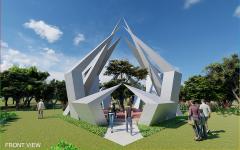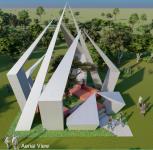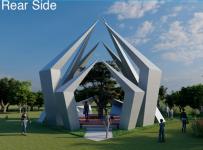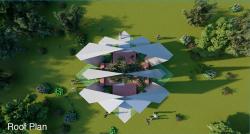NAMASTE INDIA - A Tribute to the Past and a Vision to the Future
Notions of India is an opportunity for the participants with their design interpretation to celebrate the 75th anniversary of Independence through revisiting, reimagining and recreating India’s heightened ambitions as a global leader.
CONCEPT
Namaste, also as namaskar and namaskaram, is an Indian customary, non-contact form of respectfully greeting and honoring the opposite person or group, used at any time of day. It also has a spiritual import reflecting the belief that "the divine and self (atman, soul) is same in you and me", and connotes "I bow to the divine in you".
Etymology, Meaning and Origins
Namaste (Namas te) is derived from Sanskrit and is a combination of the word namas and the second person dative pronoun in its enclitic form, te.Namas-krita appear in Rigveda as "worship, adore", Namaskara as "exclamatory adoration, homage, salutation and worship" in the Atharvaveda, the Taittiriya Samhita, and the Aitareya Brahmana.
It is also found in numerous ancient and medieval era sculpture and mandapa relief artwork in Indian temples.
History
Excavations from the Indus Valley Civilization have revealed many male and female terracotta figures in namaste posture dated to between 3000 BC - 2000 BC.
The gesture of folding hands during a Namaste is called the Anjali Mudra. This mudra is one of the postures found in Natya Shastra Indian classical dance forms, Yoga practice, in the Indian temple architecture texts - Devata murti prakarana and painting called the Citrasutras.
Universal language
Donald Trump, the Ex-President of the United States is famous for his Namaste India greeting in 2020, making it a global Indian brand, along with the Make in India initiative.
Since Namaste is a non-contact form of greeting, Israeli Prime Minister Benjamin Netanyahu suggested using the gesture as an alternative to hand shaking during the 2020 Coronavirus pandemic as a means to prevent the spread of the virus.
Design Intentions
India celebrating its 75th Anniversary of Independence, our proposed design sculpture, Namaste India is to pay Tribute to the Past and a Vision of the Future articulating the essence of the nation and its journey into a glorious future. India has been through ups and downs, paying our respect to all who have fallen and all who built and grew with this nation.Especially during this pandemic time paying our respects to the Covid 19 warriors.
Our proposed design is integrated into the fabric of the nation, will attempt to inspire and motivate the future generation to understand the history, unity, resilience and of our great people and nation.
Design Build Form and Aesthetics
Namaste as a form will be two hands folded together with 10 fingers. The biomimetic design of the structures were developed with respect to the proportion of human fingers as much as possible. The proposed design has two parts - the structural finger members and the mandapa or platform with a tree in the central courtyard.
We, the People are India theme is evolved into Our hands theme that connects everyone or communicates to the billions giving the feeling of their own hands, the feeling of pride, the feeling of hope, the feeling of ambition and the ultimate feeling “We are India” and bringing people together as we sing “Saare Jahaan se Achaa”.
The middle members at the highest points represent the notion of India under one roof and all the other fingers represent the diversity in India. The sculpture as whole represents India’s unity, conveying a common message for the India of tomorrow across such varied languages, regions and cultures meeting the design challenge.
The whole structural fingers pointing up to the sky represents a cosmic conversation with the celestial bodies and energy flow visualizing the spiritual and universal unity.
Planning
The sculpture is intended to be facing towards the East based on the concept of Surya Namaskar - Saluting the Sun, the source of our energy. So the sculpture is aligned diagonally on the 12mx12m square site.
The design process naturally evolved into a rhombus plan representing the geographical landscape/map of India giving water bodies on the 3 sides with a central platform.
The platform is designed with reference to Vedic geometry representing the Yagna Kunda with a tree in the central courtyard. The sunken central courtyard indicates Shoonya or Zero.
Live Sculpture
The growth of the tree in the central courtyard makes the sculpture live in time travel. The movement of people in and around the sculpture adds motion representing the idea that change is the only constant.
The central courtyard also represents the Gurukul system of education practised in ancient India as a centre of interaction. The Display areas that can function as cultural, heritage and spiritual information and exchange centres giving a unique space and identity to the city.
2021
MEDIUM OF CONSTRUCTION AND INNOVATION IN MATERIAL USAGE
The finger members are tilted in different angles and tapering wider in the bend and converging in a point as a cantilevered structure. YST 355 steel hollow sections will be used as the primary medium for the flexibility of the design and durability in all weather conditions.
White Zinc sheeting covering is proposed to give the final finish of the sculpture to merge, reboot, rebuild and refresh aesthetically with all surroundings. The platform, steps and seating are proposed to be Brick built.
RESPONSIBILITY TO ECONOMY AND ENVIRONMENT
The proposed sculpture has a tree in the central courtyard to act as a focal point towards our environment.
Tata Structura YST 355 steel is the most sustainable steel available in India.
Zinc takes much less energy to refine than aluminium, copper, or stainless steel.
The proposed sculpture looks complex but is designed to be feasible for construction and transportation costs can be cut using electric vehicles and will be more green.
Jajo Joachim Gomez | Harikumar Damodaran | Deepu S | Alen Jose Vadakkan










